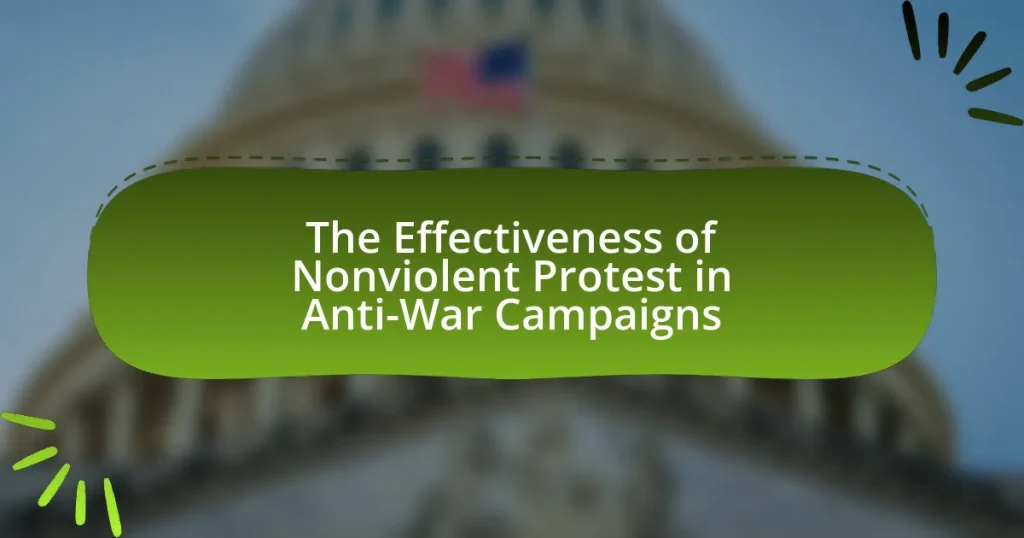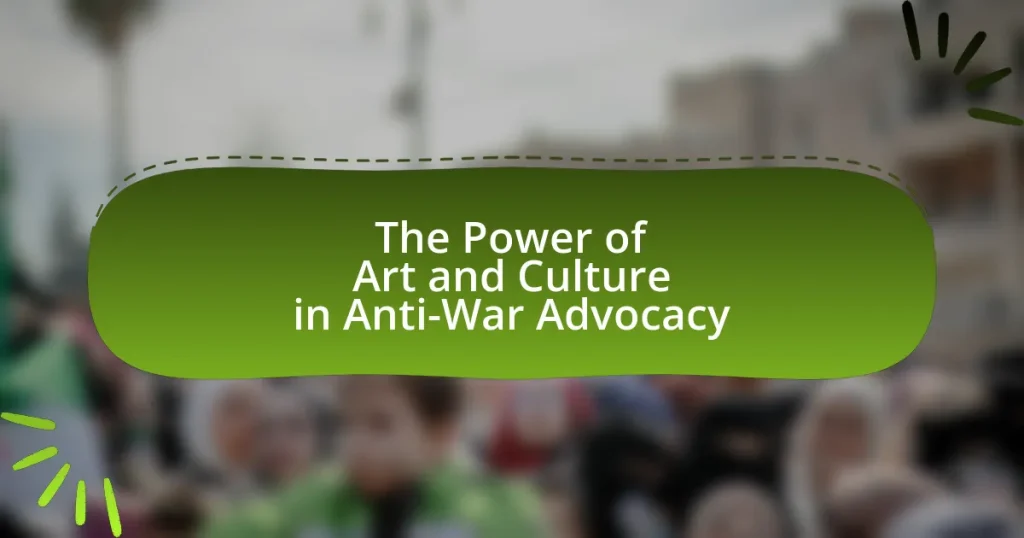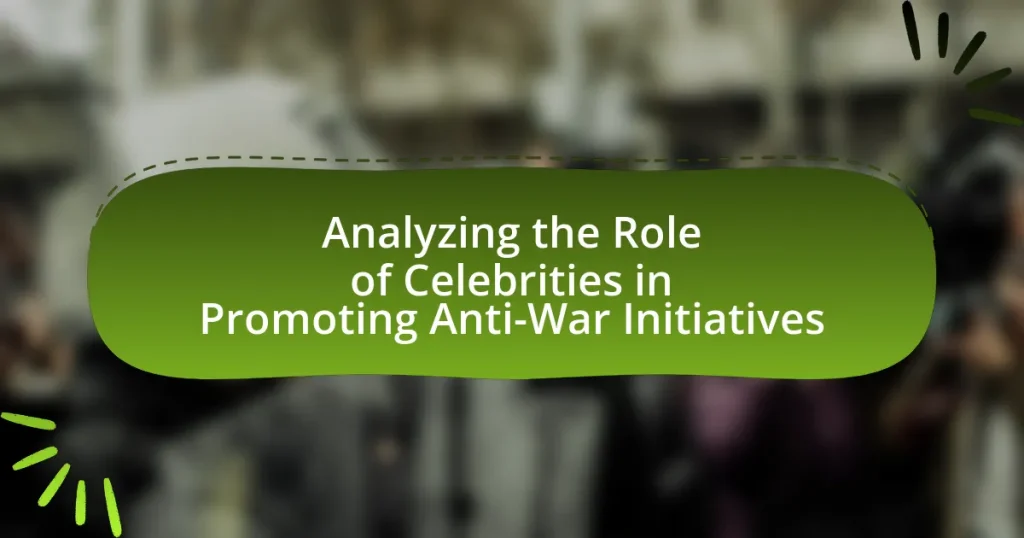Grassroots organizing for peace is a community-driven approach that promotes non-violent solutions to conflicts through local activism and coalition-building. This article explores the significance of grassroots efforts in anti-war movements, highlighting historical examples such as the Civil Rights Movement and the anti-Vietnam War protests. Key principles of effective grassroots organizing include community engagement, inclusivity, and sustained action, which empower marginalized voices and foster collective action. The article also outlines strategies for building local anti-war coalitions, addressing challenges faced by organizers, and measuring the impact of their initiatives.
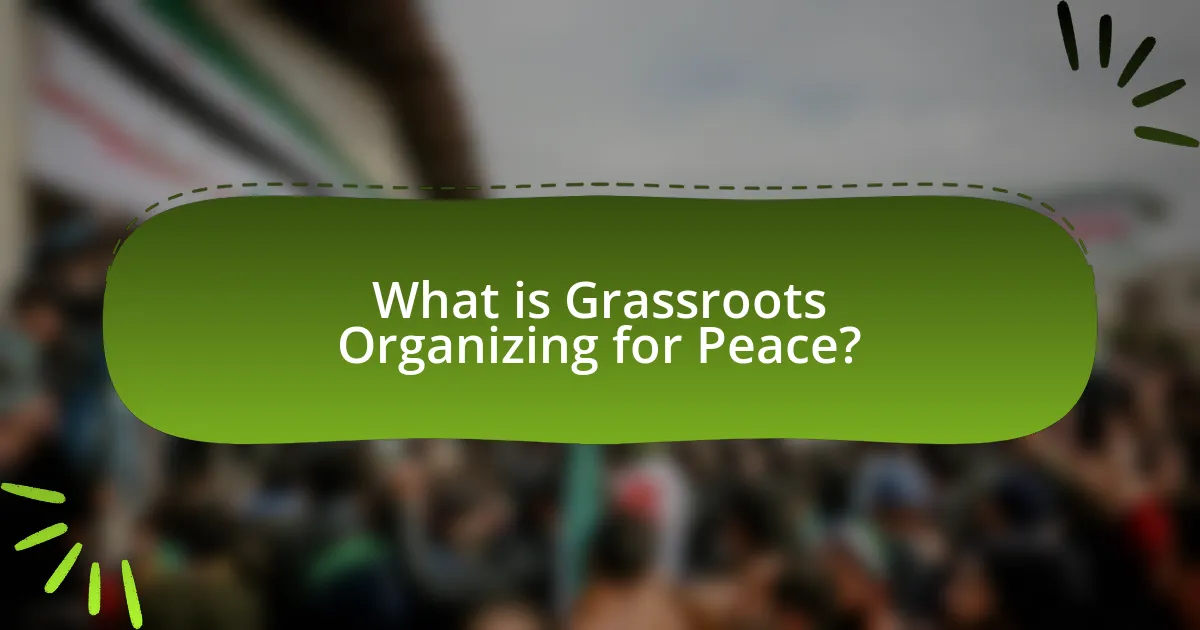
What is Grassroots Organizing for Peace?
Grassroots organizing for peace is a community-driven approach aimed at promoting peace and preventing war through local activism and coalition-building. This method involves mobilizing individuals and groups at the local level to advocate for non-violent solutions to conflicts, often focusing on education, awareness, and direct action. Historical examples include the anti-Vietnam War movement, where grassroots efforts successfully influenced public opinion and policy. Such organizing emphasizes the power of collective action and community engagement in fostering a culture of peace.
How does grassroots organizing contribute to peace efforts?
Grassroots organizing contributes to peace efforts by mobilizing communities to advocate for non-violent solutions and social justice. This form of organizing empowers individuals to collectively address local issues, fostering dialogue and understanding among diverse groups. For instance, grassroots movements like the Women’s March and local anti-war coalitions have successfully influenced public policy and raised awareness about the consequences of war, demonstrating the effectiveness of community-driven initiatives in promoting peace. Research indicates that grassroots efforts can lead to significant reductions in violence, as seen in the case of the 2011 Arab Spring, where local organizing played a crucial role in advocating for democratic reforms and peaceful protests.
What are the key principles of grassroots organizing for peace?
The key principles of grassroots organizing for peace include community engagement, inclusivity, and sustained action. Community engagement emphasizes the importance of involving local individuals in the decision-making process, ensuring that their voices are heard and valued. Inclusivity focuses on bringing together diverse groups to foster unity and collective action, recognizing that a broad coalition is essential for effective advocacy. Sustained action highlights the need for ongoing efforts and commitment to peace initiatives, rather than one-time events, to create lasting change. These principles are supported by successful movements, such as the Civil Rights Movement, which demonstrated that grassroots efforts can lead to significant social transformation.
How do local communities engage in grassroots organizing?
Local communities engage in grassroots organizing by mobilizing residents to address social issues through collective action and advocacy. They often form coalitions that focus on specific causes, such as anti-war efforts, by organizing meetings, rallies, and educational events to raise awareness and build support. For instance, the anti-war movement in the United States during the Vietnam War saw local groups organizing protests and community discussions, which significantly influenced public opinion and policy. This method of grassroots organizing empowers individuals to take ownership of their community’s challenges and fosters a sense of solidarity among participants.
Why is grassroots organizing important in anti-war movements?
Grassroots organizing is crucial in anti-war movements because it mobilizes local communities to advocate for peace and influence policy change. This form of organizing empowers individuals to voice their concerns, fostering a collective identity that amplifies the anti-war message. Historical examples, such as the Vietnam War protests, demonstrate that grassroots efforts can significantly impact public opinion and government decisions, as seen when widespread local activism contributed to the eventual withdrawal of U.S. troops. Additionally, grassroots movements often utilize direct action, community education, and coalition-building, which create a sustainable framework for ongoing resistance against militarism.
What historical examples illustrate the effectiveness of grassroots organizing?
Historical examples that illustrate the effectiveness of grassroots organizing include the Civil Rights Movement in the United States and the anti-Vietnam War protests. The Civil Rights Movement, particularly the Montgomery Bus Boycott of 1955-1956, showcased how local communities could mobilize to challenge systemic racism, leading to significant legislative changes like the Civil Rights Act of 1964. Similarly, the anti-Vietnam War protests, which gained momentum in the late 1960s, demonstrated the power of grassroots activism in influencing public opinion and policy, ultimately contributing to the U.S. withdrawal from Vietnam in 1973. Both movements relied on community organizing, coalition-building, and sustained activism to achieve their goals, proving the effectiveness of grassroots efforts in enacting social change.
How does grassroots organizing empower marginalized voices in peace advocacy?
Grassroots organizing empowers marginalized voices in peace advocacy by providing a platform for these communities to articulate their needs and perspectives directly. This form of organizing fosters inclusivity, allowing individuals who are often excluded from mainstream political discourse to engage in dialogue, mobilize support, and influence policy decisions. For instance, movements like the Women’s March and Black Lives Matter have demonstrated how grassroots efforts can elevate the concerns of marginalized groups, leading to significant social change and increased visibility in peace discussions. Research indicates that grassroots initiatives can lead to more equitable representation in peace processes, as seen in the United Nations’ recognition of the importance of local voices in conflict resolution.
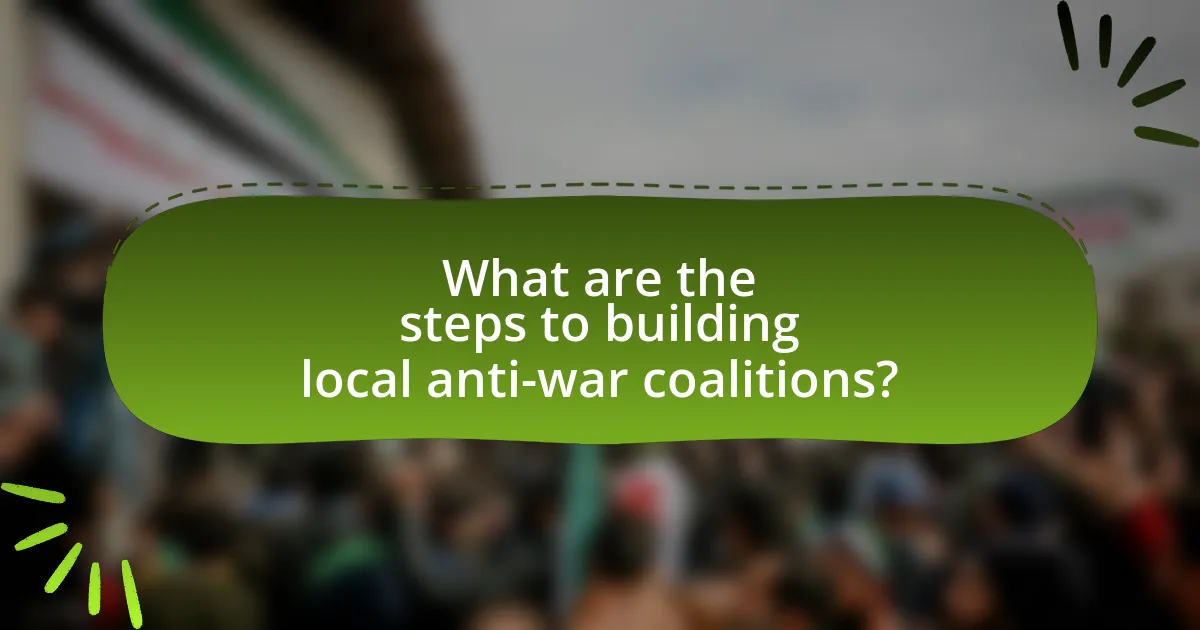
What are the steps to building local anti-war coalitions?
To build local anti-war coalitions, first identify and engage with like-minded individuals and organizations that share anti-war sentiments. This step establishes a foundational network of support. Next, organize meetings to discuss goals, strategies, and actions, ensuring that all voices are heard and included in the decision-making process. Following this, develop a clear mission statement that articulates the coalition’s objectives and values, which helps unify members and attract broader community support.
Subsequently, create outreach campaigns to raise awareness about the coalition’s cause, utilizing social media, local events, and community forums to disseminate information and gather more supporters. Additionally, establish partnerships with existing peace organizations to leverage resources and amplify the coalition’s impact. Finally, plan and execute direct actions, such as protests or educational events, to mobilize the community and demonstrate opposition to war, thereby fostering a visible presence in the local area.
These steps are supported by historical examples of successful coalitions, such as the Vietnam War protests in the 1960s, which effectively mobilized diverse groups to advocate for peace through organized grassroots efforts.
How can communities identify common goals for peace?
Communities can identify common goals for peace by engaging in inclusive dialogue that brings together diverse voices and perspectives. This process often involves organizing community meetings, workshops, or forums where individuals can express their concerns, aspirations, and ideas related to peace. Research shows that participatory approaches, such as those outlined in the “Community-Based Peacebuilding” report by the United Nations Development Programme, highlight the effectiveness of collective discussions in fostering mutual understanding and shared objectives. By synthesizing the input from these discussions, communities can articulate specific, actionable goals that reflect the collective will and needs of their members.
What strategies can be used to facilitate community discussions on peace?
To facilitate community discussions on peace, strategies such as organizing workshops, creating safe spaces for dialogue, and utilizing social media platforms are effective. Workshops can provide structured environments where community members engage in facilitated discussions, allowing for diverse perspectives to be shared. Safe spaces encourage open dialogue without fear of judgment, fostering trust among participants. Social media platforms can amplify discussions, reaching a broader audience and encouraging participation from those who may not attend in-person meetings. These strategies have been shown to enhance community engagement and promote understanding, as evidenced by initiatives like the “Peacebuilding Toolkit for Educators” developed by the U.S. Institute of Peace, which emphasizes the importance of inclusive dialogue in conflict resolution.
How do shared values influence coalition building?
Shared values significantly influence coalition building by fostering trust and collaboration among diverse groups. When organizations or individuals share common beliefs, such as a commitment to peace or social justice, they are more likely to unite their efforts toward a common goal. This alignment creates a strong foundation for cooperation, as seen in various successful grassroots movements, such as the Civil Rights Movement, where shared values of equality and justice galvanized diverse groups to work together effectively. The presence of shared values not only enhances communication but also facilitates conflict resolution, making it easier for coalition members to navigate differences and maintain focus on their collective objectives.
What roles do different stakeholders play in local anti-war coalitions?
Different stakeholders in local anti-war coalitions include grassroots activists, community organizations, political leaders, and academic institutions, each playing distinct roles. Grassroots activists mobilize public support and organize protests, while community organizations provide resources and networks for outreach. Political leaders can influence policy and lend credibility to the movement, and academic institutions contribute research and analysis to inform strategies. For example, the anti-Vietnam War movement saw diverse stakeholders unite, with activists leading demonstrations, organizations like the American Friends Service Committee facilitating community engagement, and scholars analyzing the war’s impact, demonstrating the effectiveness of collaborative efforts in achieving anti-war objectives.
How can grassroots organizations collaborate with local governments?
Grassroots organizations can collaborate with local governments by engaging in joint initiatives that address community needs and promote peace. This collaboration can take the form of co-hosting events, participating in local policy discussions, and providing valuable community insights that inform government decisions. For instance, grassroots organizations can offer data on local sentiments regarding peace initiatives, which local governments can use to shape their policies effectively. Additionally, partnerships can be formed to secure funding for community programs aimed at conflict resolution and education on peacebuilding, thereby enhancing the impact of both entities in fostering a peaceful community.
What is the significance of involving youth and students in peace coalitions?
Involving youth and students in peace coalitions is significant because they bring fresh perspectives, energy, and innovative ideas to peacebuilding efforts. Their active participation fosters a sense of ownership and responsibility towards societal issues, which is crucial for sustainable peace initiatives. Research indicates that youth engagement in peace processes can lead to more effective conflict resolution strategies, as they often challenge traditional narratives and propose creative solutions. For instance, the United Nations Security Council Resolution 2250 emphasizes the importance of youth in peace and security, recognizing their potential to contribute to conflict prevention and resolution. This involvement not only empowers young individuals but also strengthens the overall impact of peace coalitions by integrating diverse viewpoints and fostering intergenerational dialogue.
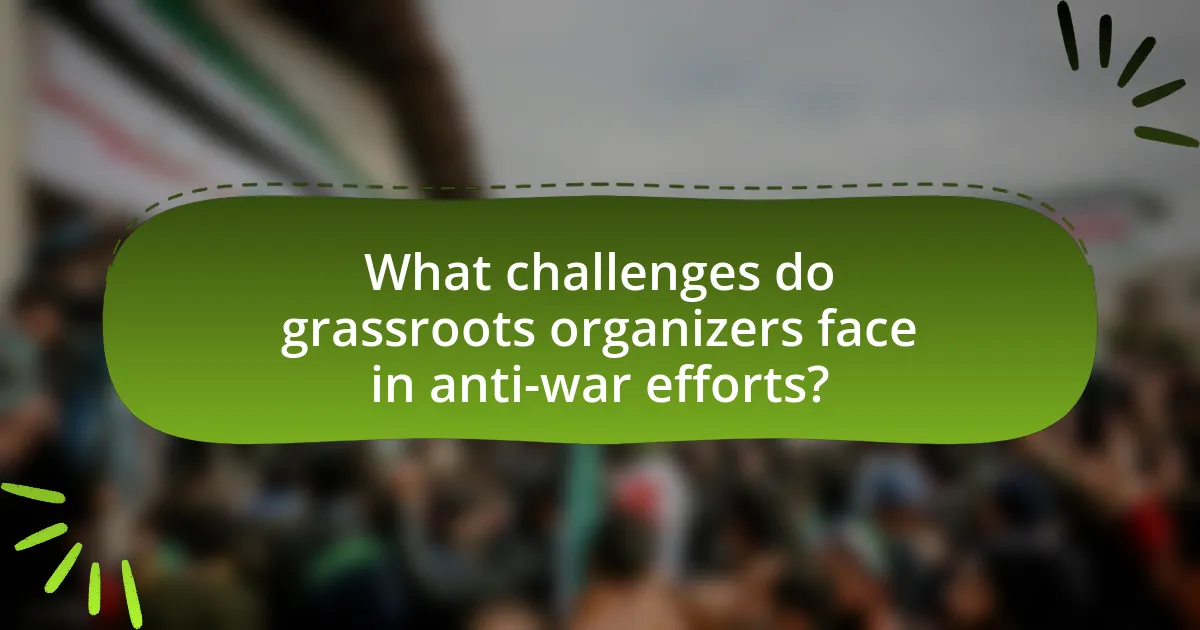
What challenges do grassroots organizers face in anti-war efforts?
Grassroots organizers in anti-war efforts face significant challenges, including limited funding, lack of media attention, and difficulties in mobilizing diverse communities. Limited funding restricts their ability to conduct outreach, organize events, and sustain campaigns, as many rely on small donations and volunteer efforts. Additionally, mainstream media often overlooks grassroots movements, making it hard for organizers to gain visibility and support for their initiatives. Mobilizing diverse communities presents another challenge, as differing perspectives on war and peace can lead to fragmentation within coalitions, complicating unified action. These challenges hinder the effectiveness and reach of grassroots anti-war efforts.
How can grassroots movements overcome funding and resource limitations?
Grassroots movements can overcome funding and resource limitations by leveraging community engagement and building strong local networks. These movements often rely on volunteer efforts, which can significantly reduce operational costs. For instance, the anti-war movement in the United States during the Vietnam War utilized grassroots organizing to mobilize large numbers of volunteers, effectively amplifying their message without substantial financial backing. Additionally, grassroots movements can seek small donations from community members, fostering a sense of ownership and investment in the cause. Research indicates that community-driven fundraising efforts can yield significant results; for example, the “GiveCamp” initiative raised over $1 million for various nonprofit projects through local contributions. By prioritizing collaboration and resource-sharing among local organizations, grassroots movements can maximize their impact while minimizing financial constraints.
What creative solutions exist for mobilizing resources in local communities?
Creative solutions for mobilizing resources in local communities include establishing community cooperatives, leveraging local crowdfunding platforms, and organizing skill-sharing workshops. Community cooperatives allow residents to pool resources and share services, enhancing economic resilience. Local crowdfunding platforms enable community members to fund projects directly, fostering a sense of ownership and investment in local initiatives. Skill-sharing workshops facilitate the exchange of knowledge and resources among residents, promoting collaboration and reducing reliance on external funding. These methods have been successfully implemented in various communities, demonstrating their effectiveness in resource mobilization. For instance, the “Time Banking” model, where individuals exchange services based on time rather than money, has shown significant success in enhancing community engagement and resource sharing.
How can coalitions address internal conflicts and maintain unity?
Coalitions can address internal conflicts and maintain unity by establishing clear communication channels and fostering a culture of inclusivity. Effective communication allows coalition members to express concerns and resolve misunderstandings promptly, which is crucial for maintaining cohesion. Additionally, promoting inclusivity ensures that diverse perspectives are valued, reducing the likelihood of conflict arising from feelings of marginalization. Research indicates that coalitions with strong communication practices and inclusive decision-making processes are more successful in sustaining unity, as evidenced by the collaborative efforts seen in various grassroots movements, such as the Civil Rights Movement, where diverse groups worked together despite internal differences to achieve common goals.
What strategies enhance the effectiveness of grassroots organizing for peace?
Effective grassroots organizing for peace is enhanced by strategies such as building strong community networks, utilizing social media for outreach, and fostering inclusive dialogue. Strong community networks create a foundation for mobilization, as evidenced by the success of organizations like the Women’s March, which united diverse groups to advocate for peace and social justice. Utilizing social media allows for rapid dissemination of information and engagement, as seen in campaigns like #NoWarOnIran, which galvanized public opinion and action. Fostering inclusive dialogue ensures that all voices are heard, promoting unity and understanding, which is crucial for sustaining long-term peace efforts. These strategies collectively empower grassroots movements to effectively challenge war and advocate for peace.
How can social media be leveraged for grassroots anti-war campaigns?
Social media can be leveraged for grassroots anti-war campaigns by facilitating rapid information dissemination, mobilizing supporters, and fostering community engagement. Platforms like Twitter and Facebook allow activists to share real-time updates, organize events, and amplify their messages to a broader audience. For instance, the #NoWar movement gained traction through viral posts and coordinated online actions, demonstrating the effectiveness of social media in rallying public support and creating a sense of urgency. Additionally, studies show that social media campaigns can significantly increase participation in protests and awareness of anti-war issues, as seen in the 2003 Iraq War protests where online organizing played a crucial role in mobilizing thousands.
What role does public education play in grassroots organizing?
Public education plays a crucial role in grassroots organizing by raising awareness and informing communities about social issues, particularly in the context of peace and anti-war efforts. It empowers individuals with knowledge, enabling them to understand the implications of war and militarization on their lives and communities. For instance, educational campaigns can highlight the economic costs of war, the impact on local resources, and the importance of peaceful conflict resolution. Research shows that informed communities are more likely to mobilize and participate in grassroots initiatives, as evidenced by the success of various anti-war movements that utilized public education to galvanize support and action.
What are best practices for sustaining local anti-war coalitions?
Best practices for sustaining local anti-war coalitions include fostering strong community engagement, maintaining clear communication, and building diverse coalitions. Community engagement ensures that members feel invested in the coalition’s goals, which can be achieved through regular meetings, outreach events, and collaboration with local organizations. Clear communication, both internally among members and externally with the public, helps to keep everyone informed and motivated, utilizing social media and newsletters to share updates and mobilize support. Building diverse coalitions that include various demographics and perspectives enhances the coalition’s reach and effectiveness, as evidenced by successful movements that have incorporated voices from different backgrounds, leading to broader support and impact.
How can coalitions measure their impact and success over time?
Coalitions can measure their impact and success over time by establishing clear, quantifiable goals and utilizing specific metrics to assess progress. For instance, they can track changes in public opinion through surveys before and after campaigns, analyze participation rates in events, and evaluate policy changes influenced by their advocacy efforts. Research indicates that coalitions that set measurable objectives, such as increasing community engagement by 30% within a year, can effectively gauge their effectiveness. Additionally, collecting qualitative data through testimonials and case studies can provide insights into the coalition’s influence on community awareness and activism.
What methods can be used to keep community members engaged and motivated?
To keep community members engaged and motivated, grassroots organizing can utilize methods such as regular communication, inclusive decision-making, and recognition of contributions. Regular communication through newsletters, social media updates, and community meetings fosters a sense of belonging and keeps members informed about ongoing initiatives. Inclusive decision-making, where members have a voice in planning and executing activities, enhances their investment in the coalition’s goals. Additionally, recognizing and celebrating individual and group contributions through events or public acknowledgments reinforces members’ commitment and motivation. Research indicates that community engagement strategies that incorporate these elements lead to higher retention rates and active participation in grassroots movements.

